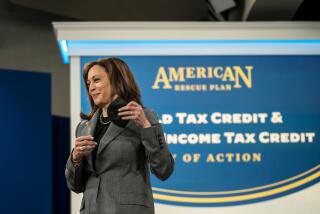Economists give Obama’s jobs plan mixed reviews
- Share via
President Obama’s proposed $447-billion package of tax cuts and infrastructure spending immediately prompted comparisons Thursday to the Recovery Act passed in early 2009, although the cost amounts to a little more than half of the stimulus.
Analysts say that stimulus package helped pull the economy out of recession, but it was nonetheless widely seen as too complicated and producing far too little bang for buck -- a perception fostered in part by the administration’s inaccurate forecasts about how high unemployment would go.
Obama’s new plan was designed to be much simpler. “I think they’ve learned from the Recovery Act and tried to make it easier to implement it and to be more effective,” said Mark Zandi, chief economist at Moody’s Analytics, a research and forecasting firm.
Zandi estimates that Obama’s new ideas, if adopted in their entirety, would add 2 million additional net jobs in 2012 and bring the unemployment rate to about 8% by the November election, compared with 9% if there was no policy change.
“It’s a bold effort to provide more support to the economy, certainly bigger than widely anticipated,” he said.
The plan offers about $245 billion in tax relief for individuals and businesses, going well beyond the payroll tax “holiday” that Congress enacted last year. Obama would expand that cut for workers, providing a $1,500 tax savings to the typical American family, up from $1,000.
The proposal would also slash the payroll tax in half for businesses with payrolls of less than $5 million, and declare a complete payroll tax holiday for employers who hire new workers or give wage increases to current employees. All companies would be eligible, but the break would be limited to the first $50 million in new payroll spending.
But the package is conspicuously absent of any specific measures to provide direct relief to distressed homeowners and the depressed housing market, a problem that many experts believe is central to the sluggish recovery.
“It was a sound bite, really,” said Nick Segal, president and founding partner of Beverly Hills-based Partners Trust Real Estate Brokerage & Acquisitions, referring to Obama’s statement that he had instructed his economic team to work with the industry to help more homeowners refinance. “We are going to refinance people’s mortgages at rates that are 4%, but the question becomes, how do they do that?”
The president’s plan also holds another potentially big risk down the road: The economic benefits in the short term will turn into drags in 2013 and the following year as the stimulus fades. And if the private-sector economy hasn’t gathered enough steam by then, the government could be looking at the possibility of another recession or left with the tough choice of having to renew or increase fiscal spending.
Business groups were unenthusiastic about Obama’s plan.
Martin Regalia, chief economist for the U.S. Chamber of Commerce, said the proposed payroll tax cut falls short of the broader tax reform needed.
“If you are trying to stimulate the economy and create jobs, there are better ways to do it, starting with a complete restructuring of the tax code for individuals and businesses,” he said. “Everyone knows it needs to be reformed. Washington needs to stop tinkering around the edges and move beyond temporary tax cuts and get to the heart of the matter.”
William Dunkelberg, chief economist for the National Federation of Independent Business, a small-employer lobbying group, doubts it will push many more small companies to add new workers.
Small firms traditionally have led the hiring coming out of recessions, but this time they’ve been on the sidelines. Dunkelberg says that’s mainly because they’re not generating enough sales and don’t have confidence in the future.
“You just got a gift of cash,” he said of the prospect of payroll tax cuts for employers. “But once you get that, why would you make a bad investment and hire an employee who five minutes ago didn’t look good and couldn’t earn enough to pay for itself?”
Still, some businesses applauded a plan that would provide immediate tax relief to employers – albeit with reservations about what it would mean for the nation’s deficits.
“I love it from my standpoint, but looking at it from the government’s standpoint, can they afford to do that?” said Kim Megonigal, chairman of Irvine-based Kimco Staffing Services, which operates 40 offices in California.
Under Obama’s plan, Megonigal stands to save $155,000 from the 50% payroll tax cuts of his existing employees. Additionally, he would save as much as about $6,600 in payroll taxes for every new employee he adds as long as that represents overall growth in payroll up to $50 million from the prior year.
Kimco hired workers in the first half of this year, but like many other companies, that stopped in early summer as the economy and outlook turned increasingly worse.
“It’s a wonderful way to incentivize business [to hire] because you can invest at a lower cost,” he said. “That’s amazing. I wasn’t expecting anything like this. It just seems too rich. I don’t get how you do it. I mean you have to balance the budget.”
More to Read
Get the L.A. Times Politics newsletter
Deeply reported insights into legislation, politics and policy from Sacramento, Washington and beyond. In your inbox twice per week.
You may occasionally receive promotional content from the Los Angeles Times.











